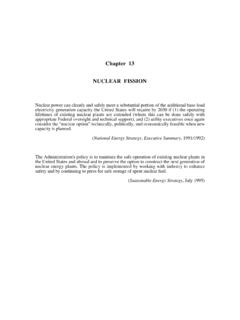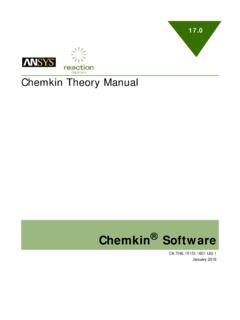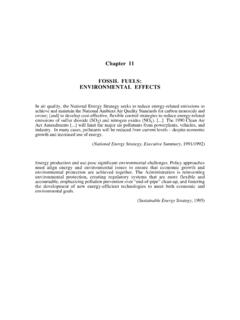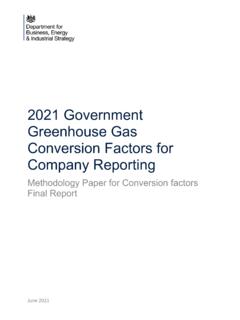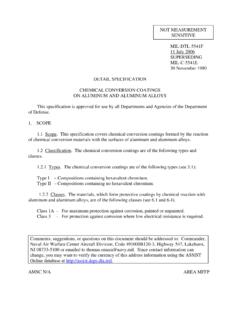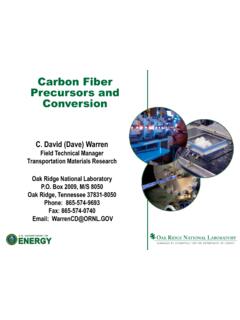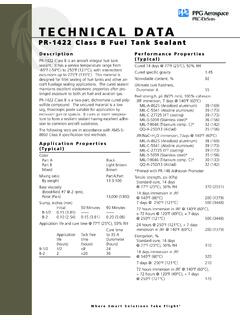Transcription of Chapter 4 EFFICIENCY OF ENERGY CONVERSION
1 Chapter 4 EFFICIENCY OF ENERGY CONVERSIONThe National ENERGY Strategy reflects a National commitment to greater EFFICIENCY in everyelement of ENERGY production and use. Greater ENERGY EFFICIENCY can reduce ENERGY costs toconsumers, enhance environmental quality, maintain and enhance our standard of living,increase our freedom and ENERGY security, and promote a strong economy.(National ENERGY Strategy, Executive Summary, 1991/1992)Increased ENERGY EFFICIENCY has provided the Nation with significant economic,environmental, and security benefits over the past 20 years. To make further progresstoward a sustainable ENERGY future, Administration policy encourages investments inenergy EFFICIENCY and fuel flexibility in key economic sectors. By focusing on marketbarriers that inhibit economic investments in efficient technologies and practices, theseprograms help market forces continually improve the EFFICIENCY of our homes, ourtransportation systems, our offices, and our factories.
2 (Sustainable ENERGY Strategy, 1995)54 Chapter 4 Our principal criterion for the selection of discussion topics in Chapter 3 was to provide thenecessary and sufficient thermodynamics background to allow the reader to grasp theconcept of ENERGY EFFICIENCY . Here we first want to become familiar with ENERGY conversiondevices and heat transfer devices. Examples of the former include automobile engines, hairdriers, furnaces and nuclear reactors. Examples of the latter include refrigerators, airconditioners and heat pumps. We then use the knowledge gained in Chapter 3 to show thatthere are natural (thermodynamic) limitations when ENERGY is converted from one form toanother. In Parts II and III of the book, we shall then see that additional technicallimitations may exist as well. This is especially true for the practically important conversionof heat to work. Finally, here we quantify EFFICIENCY and show why some energyconversion devices are more efficient than others.
3 Higher ENERGY EFFICIENCY translatesdirectly into lower ENERGY cost. We shall illustrate this statement in the present Chapter andthen use the same type of analysis throughout the remainder of the CONVERSION Devices and Their EfficiencyA device is a piece of equipment that serves a specific purpose. An ENERGY conversiondevice converts one form of ENERGY into another. It is an important element of progress ofsociety. In fact, one can discuss the history of civilization in terms of landmarks in thedevelopment of ENERGY CONVERSION devices, as illustrated below:Landmark EventApproximate DateEmergence of man4,000,000 of human civilization5000 of the water wheel350 of the windmill950 of the cannon1318 of first atmospheric steam engine (Newcomen)1712 of modern steam engine (Watt)1765 of high-pressure steam engine (Trevithick)1802 of the automobile engine (Daimler)1884 of first nuclear power plant1954 Industrial Revolution began when James Watt invented the steam engine in 1765;today we live in the nuclear age, marked by the existence of devices (reactors or bombs)that convert nuclear ENERGY into other ENERGY ENERGY CONVERSION device is represented schematically in Figure 4-1.
4 It may be avery simple gadget, such as an electric toy automobile (which converts electricity intomechanical ENERGY ), or a very complex machine, such as an automobile engine (whichconverts the chemical ENERGY of gasoline into mechanical ENERGY ). As shown in Figure 3-3 EFFICIENCY OF ENERGY CONVERSION55for systems in general, these devices will be pretty much black boxes for us. We shall notplace undue emphasis on how they work; we shall concentrate on what they accomplish. Inother words, ENERGY supply (output) and demand (input), at this microscale, will be ourfocus. This is illustrated in Figure 4-1. ENERGY supply and demand at the macroscale(United States and the world), which will be the focus of our discussion in Parts II and IIIof the book, are very much dependent on the balance between ENERGY input and output inthe devices that we use in our homes and at ConversionDeviceEnergy InputEnergy OutputEnergy Output = ENERGY Input (1st Law)Useful ENERGY Output ENERGY Input (2nd Law)FIGURE 4-1.
5 Schematic representation of an ENERGY CONVERSION EFFICIENCY of an ENERGY CONVERSION device is a quantitative expression of this balancebetween ENERGY input and ENERGY output. It is defined as follows:Device EFFICIENCY = Useful ENERGY outputEnergy inputThe key word in the above definition is useful . Were it not for this word, of course, thedefinition would be trivial, as shown in Figures 3-3 and 4-1. The First Law ofThermodynamics tells us that ENERGY is conserved in all its transformations. So the ratio ofenergy output to ENERGY input is always unity, or 100%.The meaning of the word useful depends on the purpose of the device. For example,if the device is an electric heater, the useful ENERGY output is heat, and the ENERGY input iselectricity. Electricity is converted to heat. Heat is also obtained from electricity in a lightbulb, as we well know. But this is not the useful ENERGY obtained from a light bulb; thepurpose of a light bulb is to convert electricity into light.
6 Table 4-1 summarizes the usefulenergy output and ENERGY input for some common ENERGY CONVERSION devices. Figures 4-2and 4-3 are illustrations of how to use the information provided in Table 4-1 for the case oftwo ubiquitous devices, an electric motor and a furnace. We may know, or may be56 Chapter 4interested in knowing, how they work, but this is not necessary for our purposes. Forbecoming an ENERGY -informed and (perhaps more importantly) ENERGY -conscious memberof society, all one needs is the information provided in Table 4-1 Tasks performed by common ENERGY CONVERSION devicesEnergy CONVERSION DeviceEnergy InputUseful ENERGY OutputElectric heaterElectricityThermal energyHair drierElectricityThermal energyElectric generatorMechanical energyElectricityElectric motorElectricityMechanical energyBatteryChemical energyElectricitySteam boilerChemical energyThermal energyFurnaceChemical energyThermal energySteam turbineThermal energyMechanical energyGas turbineChemical energyMechanical energyAutomobile engineChemical energyMechanical energyFluorescent lampElectricityLightSilicon solar cellSolar energyElectricitySteam locomotiveChemicalMechanicalIncandescent lampElectricityLightElectricmotorElectri city(input)Mechanical ENERGY (output)FIGURE 4-2.
7 ENERGY CONVERSION in an electric motor (electric-to-mechanical). EFFICIENCY OF ENERGY CONVERSION57 Illustration 4-1. An electric motor consumes 100 watts (W) of electricity to obtain 90watts of mechanical power. Determine its EFFICIENCY (E). power is the rate of ENERGY utilization, EFFICIENCY can also be expressed as apower ratio. The time units cancel out, and we haveEfficiency = Useful ENERGY outputEnergy input = Useful power output Power inputTherefore, the EFFICIENCY of this electric motor is:E = Mechanical ENERGY (power) output Electric ENERGY (power) input == 90 W100 W = 90 Js100 Js = 90 J100 J = = 90%FurnaceChemical ENERGY (input)Thermal ENERGY (output)FIGURE 4-3. ENERGY CONVERSION in a furnace (chemical-to-thermal).Illustrations 4-1 and 4-2, while very simple, should be studied carefully. They carry twoimportant messages. First, the EFFICIENCY of an ENERGY CONVERSION device is a quantitativelyunitless (or dimensionless) number between 0 and 1 (or between 0 and 100%).
8 Obviously,the larger this number is, the higher the EFFICIENCY of the device will be; however, a numbergreater than one would contradict the First Law of Thermodynamics. The second messageis both formal and substantive. Its formal part has to do with the cancellation of units (see58 Chapter 4pp. 15-17). It is not sufficient to convert ENERGY quantities into the same units, for exampleBTU to joules or calories to kilowatthours. The units must also be of the same energyform. It is not possible, for example, to cancel out chemical BTU and thermal BTU. Insubstantive terms, the EFFICIENCY is not a qualitatively unitless number. Even when its unitsare not explicitly stated, as in Illustration 4-1, we should remember what they are, fromknowledge of the device's function (as shown in Table 4-1 and illustrated in Figures 4-1,4-2 and 4-3).Illustration 4-2. A gas furnace has an EFFICIENCY of 75%. How many BTU will itproduce from 1000 BTU of natural function of a gas furnace is to convert the chemical ENERGY of the gas into heat(thermal ENERGY ), as shown in Table 4-1 and illustrated in Figure , we have:Useful ENERGY output = [ ENERGY input] [ EFFICIENCY ]= [1000 BTU (chemical ENERGY )] [75 BTU (thermal ENERGY ) 100 BTU (chemical ENERGY ) ]= 750 BTU (thermal ENERGY )The concept of EFFICIENCY thus embodies both laws of thermodynamics.
9 It reflects thequantitative equality and the qualitative difference of the various ENERGY forms. Itsunderstanding requires some knowledge of thermodynamics; once understood, it is onlythis concept from the entire field of thermodynamics that is necessary for understandingthe principal ENERGY issues facing society 4-2 summarizes the ENERGY efficiencies of a number of common ENERGY conversiondevices. They are listed in order of decreasing EFFICIENCY . The numbers shown are typicalbut they can be different for different models of the same type of device (depending ondetails of its design) or for the same device, depending on whether it is used andmaintained properly. For example, your car engine will be more efficient if you change theoil some numbers are high and others are low can be understood, at least in part,from the information provided in Chapter 3. The easiest conversions are those that are inthe direction of increasing entropy, and in particular those that produce heat (thermalenergy).
10 We just need to rub our hands and convert mechanical ENERGY into heat. So theelectric drier and the electric heater are very efficient. Home furnaces also produce heat, butEFFICIENCY OF ENERGY CONVERSION59gas furnaces are typically more efficient than oil furnaces, which in turn are often moreefficient than coal furnaces. The reason for this is that it is easiest to burn the gascompletely within the furnace, and it is most difficult to burn coal. In other words, thelargest part of the chemical ENERGY of the gas ends up as useful heat in our home. This isdiscussed in more detail in Chapters 6-9. Note also the low efficiencies of such commondevices as the steam turbine and automobile engine. The reason for this is explored 4-2 Efficiencies of common ENERGY CONVERSION devicesEnergy CONVERSION DeviceEnergy ConversionTypicalEfficiency, %Electric heaterElectricity/Thermal100 Hair drierElectricity/Thermal100 Electric generatorMechanical/Electricity95 Electric motor (large)Electricity/Mechanical90 BatteryChemical/Electricity90 Steam boiler (power plant)Chemical/Thermal85 Home gas furnaceChemical/Thermal85 Home oil furnaceChemical/Thermal65 Electric motor (small)Electricity/Mechanical65 Home coal furnaceChemical/Thermal55 Steam turbineThermal/Mechanical45 Gas turbine (aircraft)Chemical/Mechanical35 Gas turbine (industrial)


